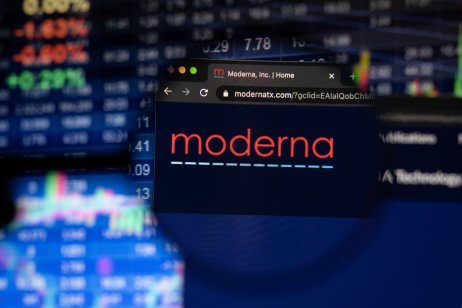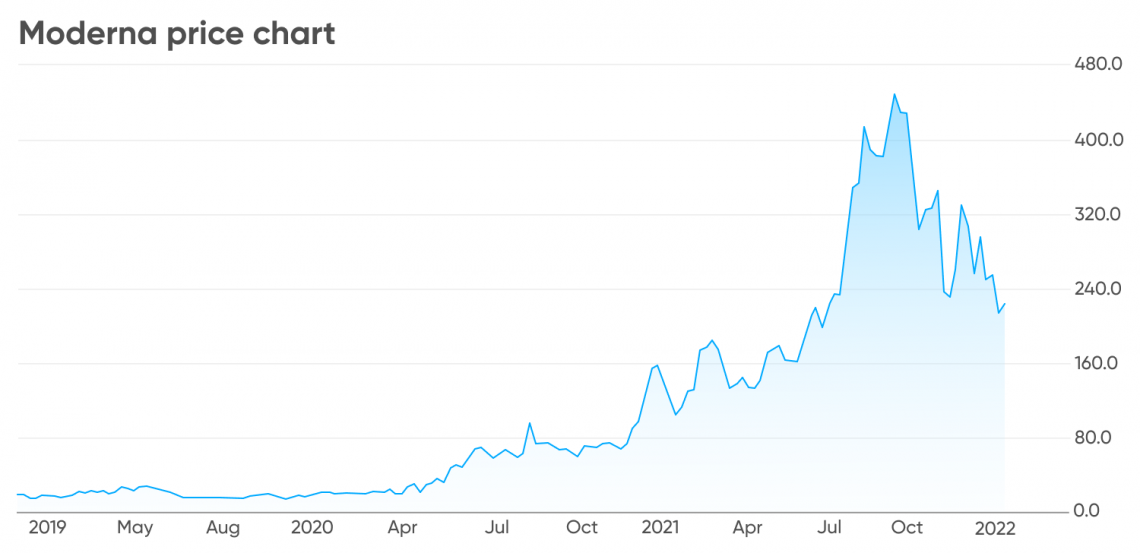Moderna (MRNA) stock forecast: a shot away from soaring stocks?

Covid-19 has proven to be a downer for most business sectors and the economy as a whole. However, it has also provided growth opportunities for pharmaceutical companies.
With research and innovation, more and more pharma companies have thrown themselves into finding coronavirus treatments. Moderna (MRNA) is no different. Established in 2010, this US-based pharmaceutical and biotechnology company focuses on RNA therapeutics, primarily mRNA vaccines.

On 6 December 2018, Moderna launched its initial public offering (IPO) and began trading on the NASDAQ. The IPO raised approximately $605m ($26.3m shares at $23 a share).
On 18 December 2020, Moderna announced in a press release that the US Food and Drug Administration (FDA) has authorised the emergency use of the vaccine the company had developed to combat Covid-19 for individuals aged 18 or above.
Codenamed mRNA-1273 and sold under the brand name Spikevax, Moderna developed its Covid-19 vaccine in collaboration with the US National Institute of Allergy and Infectious Diseases and the Biomedical Advanced Research and Development Authority.
The CEO of Moderna, Stéphane Bancel, thanked the participants and staff involved in the clinical trials, saying:
“I am proud of what the Moderna team has achieved in collaboration with our partners. We were able to create and manufacture the Moderna Covid-19 vaccine in 11 months from sequence to authorisation while advancing clinical development with a Phase 1, Phase 2 and pivotal Phase 3 study of 30,000 participants. We remain focused on scaling up manufacturing to help us protect as many people as we can from this terrible disease.”
However, in the first week of 2022, the stock experienced a steady downfall. From the close price of $235.05 on 3 January 2022, the stock closed at $213.86 on 7 January 2022 – a 9.01% fall.
After reaching a record-high of $484.47 on 9 August 2021, the Moderna stock charts closed on 31 December 2021 at $253.98 – a fall of 47.57%. As the company navigates the market, join us as we take up a Moderna stock analysis and consider analysts’ comments on Moderna’s future stock price.

Stock fundamental analysis
On 4 November 2021, the company published its financial results for Q3 2021. With revenues of $4.9bn, the company has increased its top-line numbers since Q3 2020’s reported revenues of $157m.
For the three months ended 30 September 2021, the company reported net income of $3.3bn. This is in stark contrast to the net loss of $233m published for the same period in 2020.
With respect to research and development, the company reported $521m in expenses incurred during Q3 2021. That’s a 51.45% increase from the reported research and development expenses of $344m in Q3 2020. The clinical development of the mRNA-1273 vaccine by way of trial expenses and personnel-related costs accounts for the $177m increase in R&D.
Moving forward in 2022, Bancel has set the bar high for Moderna stock expectations as the company focuses on advancing many other mRNA platform-driven programs in its pipeline.
The company expects its 2022 sales to be in the range of $17bn to $22bn. In its Q3 2021 financial results, it mentions having signed approximately $17bn of advance purchase agreements (APAs) for delivery in 2022. It also anticipates the exercise of options of up to $3bn, through its 2022 APAs.
Additionally, the company continues to steer conversations with several international organisations and governments, such as COVAX, the Pan American Health Organisation (PAHO) and the African Union, for furthering its 2022 APAs.
Stock price news
The first week of 2022 has been disappointing for Moderna stock projections, having reportedly experienced a fallback of almost 10%.
The stock plummeted downwards throughout December 2021. From a close price of $310.61, as of 1 December 2021, the stock fell by 18.23% and closed at $253.98 on 31 December 2021.
On 30 November, just days after the first Omicron case was detected in South Africa, the head of Moderna expressed concern about the current crop of vaccines not being effective against the new strain.
With mRNA-1273 being the company’s only commercial product at this time, this affected investors’ confidence in the Moderna’s prospects. Additionally, the early human trial results from the company’s experimental seasonal quadrivalent flu vaccine (mRNA-1010) have been underwhelming.
On 10 December 2021, Moderna published interim Phase 1 data, which reportedly didn’t show any greater immune responses than an already available vaccine from Sanofi, specifically in older adults. This further puts the success of Moderna’s flu vaccine in question.
In the latest Moderna stock news, Bancel spoke of the company’s updates at the 40th annual J.P. Morgan Healthcare Conference on 10 January 2022. He mentioned that to tackle Omicron, Moderna is developing a booster along with public health leaders worldwide.
The anticipated rollout for this booster is during the autumn of 2022, with clinical trials set to begin soon. The markets cheered this news, driving Moderna’s stock up 9.2% in a single day to a close of $233.70.
Stock technical analysis
Milan Vaishnav, CMT, MSTA and a consulting technical analyst at Gemstone Equity Research & Advisory Services, shares a technical analysis for Moderna, telling Capital.com:
Future price forecast
At least 16 Wall Street analyst predictions, as compiled by TipRanks, suggest a consensus MRNA target for the 12-month share price at $317.69 a share. The stock projection varied from the low of $135 to the high of $506. The average price target represents a 35.93% upside from the latest trading price of $233.70 (12 January).

According to the algorithmic forecasting of Wallet Investor, as of 10 January 2022, the Moderna stock market price could increase to $570.661 by January 2025. Additionally, in its MRNA stock forecast, it mentioned that the price could potentially be at a close price of $333.892 by December 2022.
Following the company’s Q3 2021 results, several analysts have revised their Moderna stock price prediction. Jefferies cut its price target from $375 to $325 and recommended to ‘hold’ the stock, as of 5 November 2021. On the same day, Morgan Stanley lowered its Moderna stock price target from $337 to $313 and gave it an ‘equal weight’ rating. On 23 December 2021, SVB Leerink restated its ‘sell’ recommendation.
When looking for a Moderna share price forecast, it’s important to bear in mind that analysts’ forecasts and price targets can be wrong. An analyst’s Moderna stock long-term forecast is based on making fundamental and technical studies of the stock’s performance. Past performance is no guarantee of future results.
FAQs
Is MRNA a good stock to buy?
According to data compiled by Tip Ranks, based on 16 Wall Street analysts, seven have given the stock a ‘buy’ recommendation, three have maintained a ‘sell’ rating, while six have it on ‘hold’. On 10 January 2022, the company’s CEO boosted investor’s confidence by his comment on the company’s continued efforts to build a booster against the Omicron variant of Covid-19.
Note that analyst predictions are often wrong. Forecasts shouldn't be used as a substitute for your own research. Always conduct your own due diligence before investing. And never invest or trade money you cannot afford to lose.
Will the MRNA stock go up?
According to an algorithmic-based application, Wallet Investor, the share price for MRNA could go as high as $570.661 as of January 2025.
Markets in this article
